When you’re knitting or crocheting in the real world (read: with all manor of kids, pets, co-workers, friends, and spouses underfoot), there are tons of opportunities for things to go terribly, terribly wrong. But, thankfully, they don’t have to.
If you’ve ever snapped at your partner for interrupting you in the middle of a row or cried as you ripped out a lace repeat for the sixth damn time because you just keep getting distracted and losing your place, this post is for you.
Note: I use knitting in my examples below, but the same tips and tricks for staying on track can also be used for crochet projects. (Obviously, this excludes the bits about counting the number of stitches on your needles. Unless, of course, you’re working on some Tunisian crochet.)
Know Your Rows: Make a Row and Stitch Count List:
Unless you’re knitting in the quietest, coziest, most distraction-free nook imaginable, at some point, you’re going to lose your place in your pattern. And, when you do, you’ll probably consider screaming, crying, and/or indulging in some delightfully creative swearing. (We’ve all been there, so feel free to share your favorite knitting-related expletives in the comments. In case you’re wondering, I tend to alternate between dropping a good old fashioned F-bomb and yelling something hilariously old-timey like “CONSARNIT!” when I experience an epic knitting fail.)
Okay, now that we’ve gotten all of the swears out of our systems, there’s good news! The what-the-hell-row-am-I-on problem is easily prevented with a few minutes of prep work.
First, take a look at your knitting pattern. Some will individually list out every single row or round, then, in parentheses (or in brackets, or in nothing at all) at the end of each line, they’ll tell you the number of stitches that you should have on your needle once the row/round has been completed. These kinds of patterns are my favorite, and they get a gold star. If you lose your place, you can simply count your stitches—or, if you’re in the middle of a complex increase/decrease/lace pattern, rip or knit the stitches back to the beginning of the row/round and then count them—to find the corresponding row on your pattern. (If you’re working on a project with multiple repeats of the exact same row/round/stitch pattern, scroll on down to the Quick and Easy Stitch and Row Counting section for tips on keeping track of how many you’ve already completed.)
But, wait! What if my pattern doesn’t list all of the rows and all of the stitch counts?
You can make your own row and stitch counting list, of course!
What you’ll need:
- Paper
- A pen or pencil
- Your knitting pattern
- A highlighter or pen in a bright color (optional)
- A calculator (optional, but definitely helpful for more complicated increase or decrease rows)
Step 1:
To get started, take a moment to read through the pattern to familiarize yourself with any recurring pattern repeats or special instructions. Then, on a blank piece of paper (or right on the pattern, if there’s room), make a numerical list of all of the rows/rounds in the pattern.
Example a:
If your pattern looks like this:
CO 4 sts.
Row 1: Knit.
Row 2: K2, M1, K2.
Row 3: Knit.
Row 4: K2, M1, knit until 2 sts remain, M1, K2.
Row 5-6: Knit.
Repeat rows 4-6 two (2) more times.Abbreviation key: CO=cast on, K=knit, M1=make one increase, sts=stitches.
you should number your list from 1-12, because there are 12 total rows in your pattern.
Example b:
CO 4 sts. [CO]
Row 1: Knit. [row 1]
Row 2: K2, M1, K2. [row 2]
Row 3: Knit. [row 3]
Row 4: K2, M1, knit until 2 sts remain, M1, K2. [row 4]
Row 5-6: Knit. [row 5][row 6]
Repeat rows 4-6 two (2) more times. Repeat 1: [row 7][row 8][row 9]; Repeat 2: [row 10][row 11][row 12] **each repeat adds 3 rows.Abbreviation key: CO=cast on, K=knit, M1=make one increase, sts=stitches.
I know that repeats can be confusing, so I’ve numbered each row in blue in example b above.
In longer or particularly complex patterns, I generally do this in sections so I’m not trying to juggle hundreds of rows all at the same time.
Note: If it will help you keep track, you can also include the cast-on at the beginning of your list. If you do, your list should start with CO, then have numbers 1-12 for the 12 total rows.
Step 2:
I’m not gonna lie, the next part in this process—figuring out the stitch count for each row—is kind of tedious. But, it’s also well worth the effort on big projects when the counts aren’t provided in the pattern. (This is especially true if said projects are wearables, and you’d like them to fit when you’re finally done knitting them.) And, as my BFF pointed out, it’s also great if you’re the kind of knitter who tends to get bored and set projects aside for a week/a month/a few years while you work on something more interesting—no matter how long that half-finished sweater has been sitting at the bottom of your closet, with a quick glance at your list, you’ll know exactly where you left off.
Example c:
CO 4 sts. [CO: 4 sts]
Row 1: Knit. [row 1: 4 sts]
Row 2: K2, M1, K2. [row 2: 5 sts]
Row 3: Knit. [row 3: 5 sts]
Row 4: K2, M1, knit until 2 sts remain, M1, K2. [row 4: 7 sts]
Row 5-6: Knit. [row 5: 7 sts][row 6: 7 sts]
Repeat rows 4-6 two (2) more times. Repeat 1: [row 7: 9 sts][row 8: 9 sts][row 9: 9 sts]; Repeat 2: [row 10: 11 sts][row 11: 11 sts][row 12: 11 sts] **each repeat adds 2 sts.Abbreviation key: CO=cast on, K=knit, M1=make one increase, sts=stitches.
2a:
If you’ve included the cast-on in your list, write the number of stitches in the cast-on next to CO at the top of your paper.
Now, take a look at the first row in your pattern. Count the number of stitches that are on your needle at the beginning of the row, then add or subtract stitches from that number for any increases or decreases that appear in the row. This will tell you how many stitches should be on your needle at the end. (Easy, yes?) Write this number next to the first row on your list.
- Row 1 is a knitted row with no increases or decreases, so you should start with 4 stitches on your needle from the cast on, and you should finish with 4 stitches on your needle at the end of the row. [4 sts]
2b:
Now, let’s try the same method, but this time we’ll use an example row with an increase.
- Row 2 contains 1 increase (M1).
First, I’ll take you through the math the long way: Working row 1, you’ll knit 2 stitches, increase 1 stitch, and knit the final 2 stitches on your needle. Adding up all of the stitches (the bolded numbers), the total number of stitches on your needle at the end of the row will be 5.
Now, let’s make the math even easier: You know that you’ve started with 4 stitches on the needle and that the row contains 1 increase. Since 4+1=5, you’re clearly going to finish with 5 stitches on the needle, right? Magic! No actual thought required. [5 sts]
Write down the stitch count for the second row next to row 2 on your list.
2c:
To make sure that everything’s clear, I’ll walk you through the remaining rows in the example, including the repeat at the end. If you’ve already got your mind wrapped around the process, you can just skim the rest of this step.
For a quick reference, I’ve also noted the stitch counts for each row in blue on example c above.
- Row 3 is a knitted row with no increases or decreases. You’ll start with the 5 stitches that you had on your needle at the end of row 2, and you’ll finish with 5 stitches on your needle at the end of this row. [5 sts]
- Row 4 contains 2 increases (M1). You’ll start with the 5 stitches that you had on your needle at the end of row 3, then add the 2 increase stitches to finish the row with 7 stitches on your needle. [7 sts]
- Rows 5 and 6 are knitted rows with no increases or decreases. You’ll start with the 7 stitches that you had on your needle at the end of row 4, then you’ll finish both rows with the same 7 stitches. [7 sts]
First repeat of rows 4-6:
- Row 7—which is a repeat of row 4— contains 2 increases (M1). You’ll start with the 7 stitches that you had on your needle at the end of row 6, then add the 2 increase stitches to finish the row with 9 stitches on your needle. [9 sts]
- Rows 8 and 9 —which are a repeat of rows 5 and 6— are knitted rows with no increases or decreases. You’ll start with the 9 stitches that you had on your needle at the end of row 7, then you’ll finish both rows with the same 9 stitches. [9 sts]
Second repeat of rows 4-6:
- Row 10—which is a repeat of row 4— contains 2 increases (M1). You’ll start with the 9 stitches that you had on your needle at the end of row 9, then add the 2 increase stitches to finish the row with 11 stitches on your needle. [11 sts]
- Rows 11 and 12 —which are a repeat of rows 5 and 6— are knitted rows with no increases or decreases. You’ll start with the 11 stitches that you had on your needle at the end of row 10, then you’ll finish both rows with the same 11 stitches. [11 sts]
Here’s what the finished row and stitch count list for the example pattern would look like:
| Row 1: | 4 sts |
| Row 2: | 5 sts |
| Row 3: | 5 sts |
| Row 4: | 7 sts |
| Row 5: | 7 sts |
| Row 6: | 7 sts |
| Row 7: | 9 sts |
| Row 8: | 9 sts |
| Row 9: | 9 sts |
| Row 10: | 11 sts |
| Row 11: | 11 sts |
| Row 12: | 11 sts |
Step 3:
Now that you’ve done the math, you can use your row and stitch count list to keep track of where you are in your pattern. On my project lists, I use a highlighter to cross out each row as I complete it, then I use the stitch counts every few rows to make sure that I haven’t made a mistake in my project. (Handy, right?)
Even though this process looks like a lot of work, it actually only takes a few minutes to complete, and it can save you countless knitting-related headaches on long/complex/confusing patterns that don’t have stitch counts. (Obviously, for quick and simple patterns, this process will be overkill. If that’s the case for your current project, then, for goodness sake, don’t waste your time. Only make a row and stitch counter list if it’s actually going to help you.)
Knitting Apps:
When it comes to counting rows and stitches, your smartphone can be a fantastic knitting tool in its own right.
There are tons of phone-related knitting apps available, so I’ve put together a list of a few solid options to help get you started. (Big thanks to Chassen Bell on the TZoM Facebook page for recommending the Android apps!)
Knitting Apps for iPhone and Android:
- Knit Counter Lite (iPhone, free) **This is the app that I use.
- Knit Counter (iPhone, $3.99)
- Knitting Counter (Android, free)
- Visual Knitting Counter (Android, free)
I have an iPhone, and I generally use the Knit Counter Lite app. I like it because it’s intuitive and easy to use, and it allows me to add more than one counter to my project, which is great for separating out the stitch or row counts for pattern repeats or increase and decrease sections. (Knit Counter, the paid option listed above, is essentially the same tool, but it allows you to work on more than one project at a time.) I use my knitting apps to count rows more often than I use them to count stitches, but the apps that I’ve tried work equally well for both.
Full disclosure: I don’t have an Android phone, so I can’t personally vouch for the Android apps on the list. But, as you might expect, they seem to function pretty similarly to their iPhone counterparts. If you’re in the market for a good starter option, from what I can tell, Knitting Counter seems to offer the most basic, straightforward interface. (If you’re an Android user with a favorite app, feel free to share more recommendations in the comments!)
Wait a second. Why go to all the trouble to manually write out a row and stitch count list like the one in the previous section when there’s an app for that?
Good question. For some projects, writing out the information on paper (where you can also scribble notes and reminders) is simply easier to follow. It’s also nice to be able to clip your row and stitch count list to your pattern when you’re finished so you’ll have all of the information in one place next time you want to use it. But, there are also times when all you really need to do is count—like when your pattern already contains all of the row and stitch count information that you need—and an app is a way better option.
I choose my approach on a per-pattern basis, and it’s not unusual for me to use both an app and a written list on the same project. Example: Instead of using my written list to record the stitch count for each individual row, sometimes I use it to keep track of the stitch count for a multi-row pattern repeat instead. (This makes for a shorter written list when I’m working with a pattern that has tons of repeats, but still gives me a good reference to follow along the way.) Generally speaking, when I focus on pattern repeats in my written list instead of individual rows, I also use my app to keep a quick running tally of the rows I’ve completed. (That’s what’s going on in the photo above.)
The point: I don’t really follow any hard and fast rules when it comes to deciding between tracking my progress on paper or using an app, I simply pick the tool that seems best for the project, and then I stick with it. Don’t hesitate to mix the manual approach with electronics as you see fit!
Quick and Easy Stitch and Row Counting:
What if there are a million rows with the same stitch count, and I don’t know how many rows I’ve already completed?! Or what if there are multiple pattern repeats that are the same? How will I know which one I’m on?
Don’t panic, everything will be fine. These tips will neither hurt you nor require you to think.
What you’ll need:
Please note that the links to supplies and tools that are provided below are affiliate links, and I will be compensated if you choose to make a purchase after clicking through.
Keeping track of the number of stitches on your needles (without counting after every row):
If appropriate for the type of pattern that you’re working with, I’m a firm believer in placing a circular or split-lock stitch marker on the needle every 10 stitches. (Or every 20, 30, or even 50 stitches—it’s really up to you.) Here’s how it works:
- If you place a stitch marker every 10 stitches as you work, you can get a fast and accurate stitch count at a glance by tallying the number 10-stitch sections between your markers. When you’ve got hundreds of stitches on your needle, it saves tons of time, and can be much more precise than trying to wrangle your needles and yarn while counting individual stitches.
- With stitch markers at regular intervals between your stitches, it’s really easy to find a dropped stitch or other mistake. If you know that you should have 10 stitches between each stitch marker, the section with more stitches or fewer stitches marks the place in the row where the problem has occurred.
- If you’re working on a lace project or a pattern that has increases or decreases in the middle of the row, you can always use removable lock ring stitch markers to temporarily mark off every 10 stitches while you count so you don’t lose your place in the middle of the row. (This is especially nice for lace-weight yarn and gigantic sweaters with a million stitches.)
Keeping track of pattern repeats and other groups of stitches:
- When working on something like a lace pattern, instead of placing stitch markers at set stitch-count intervals, I often place them after each pattern repeat so I don’t get lost in the middle of a repeating section and screw up the design.
Keeping track of the number of rows or rounds that you have finished:
- This one’s simple: Immediately after you finish the first stitch in a new row or round, place a lock ring stitch marker through the stitch. Then, as you work, you can go back and count these markers to see how many rows or rounds you’ve completed. (In the round, the stitch markers will line up vertically along the center of your project. When working flat, the stitch markers will alternate back and forth along both sides of your project.)
- In addition to helping you keep an accurate count of rounds completed, placing a stitch marker in the first stitch will also signal that you’ve reached the beginning/end of each round.
Look at that! We’re done! *high fives*
One last note before you grab that yarn and prepare to cast one:
The tips I’ve shared in this post are the methods that I use every day when I’m working with a new pattern and I don’t want to get lost, but they certainly aren’t applicable to every single project or ideal for every single crafter. As I’ve mentioned before, I’m a numbers gal, and lists, charts, and figures keep me on track, help me get my work done, and make me happy. That said, I totally get that not everyone feels this way. I have plenty of [much calmer] friends who create by shape and sight, and who use patterns as guidelines rather than exact formulas. These friends are every bit as skilled as I am, and, at the end of the day, if you compared two like projects, you wouldn’t be able to tell which item was made by a numbers-obsessed tornado of productivity (me) and someone who happily placed their decreases wherever it looked right (them). So, if a less precise approach is more your style, then put down your pencil and go for it! (Just, you know, try not to scatter my papers on your way out. ;P) But, if you happen to be a guy or gal who’s always kind of liked a good spreadsheet, I really hope the information provided here will help make your future projects even better, and that you use your list-making powers for good!

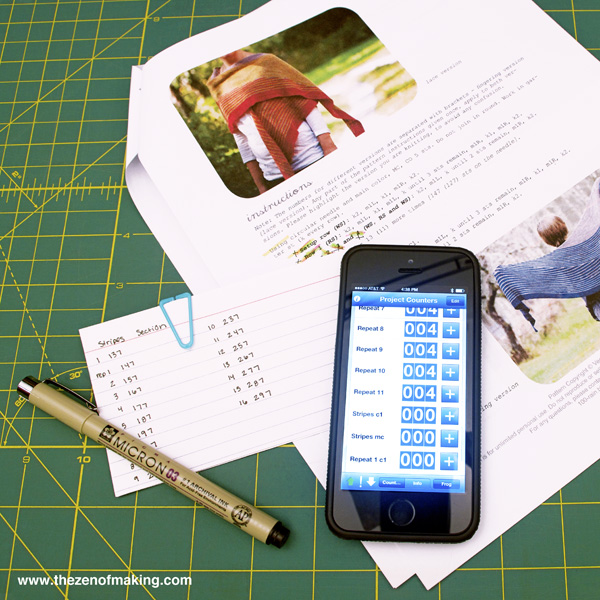
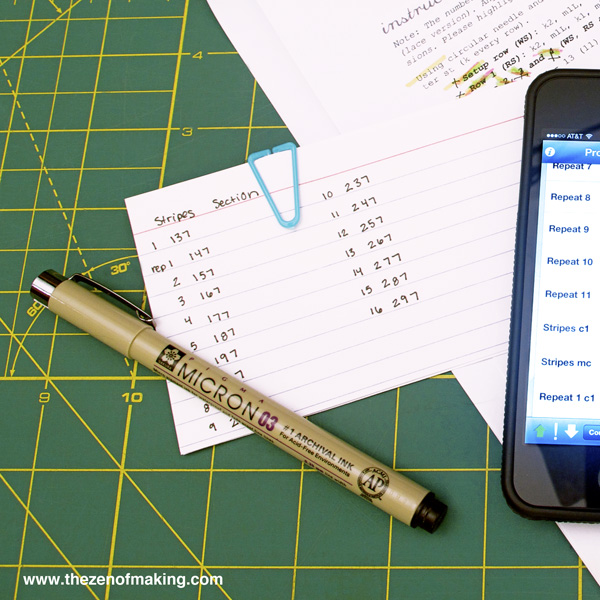
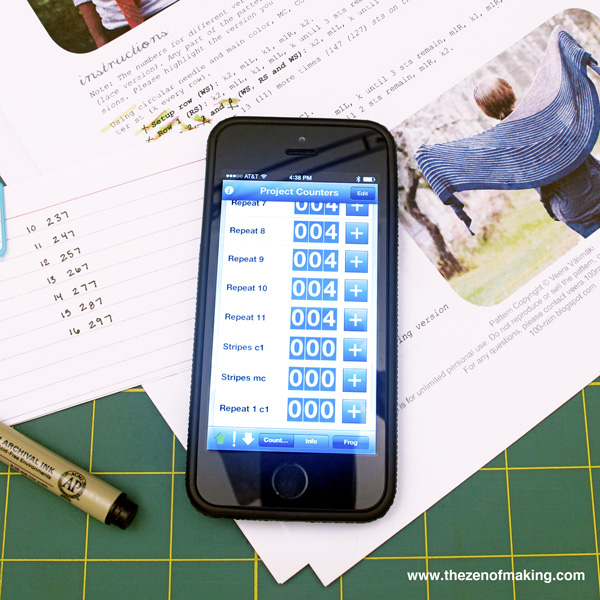
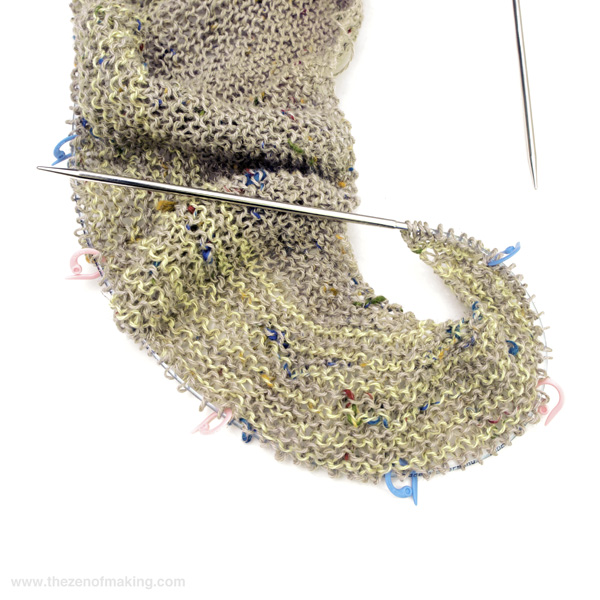
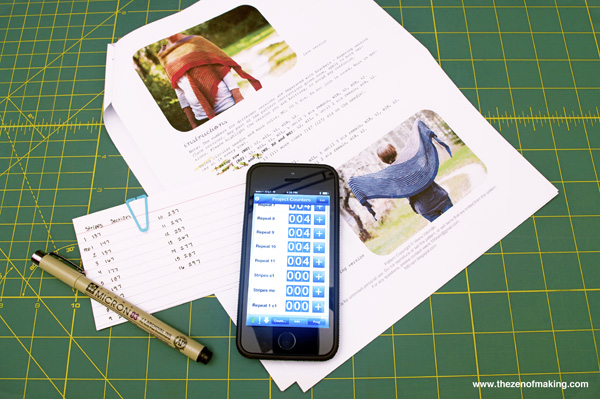
Great post! My grandmother swears by using bobby pins to keep track of rows. Super cheap and you don’t have to keep counting rows over and over again, just put them in every five, or two or every repeat. My knitting buddies can tell you, I’m a bobby pin evangelist.
Ooh, yes! Bobby pins are a great idea!
I count my YO on purl side of lace. Ifall yo are in right spot I am good. To do this an example is Row 1 : k3 YO K 4 . Om ws would be p4 YO is 5th stitch . I did this on Begonia swirl and Lace Blue Bird scarf.
I’m more one of those shape-and-feel knitters, but I do have a trick for keeping track of my place in my “patterns”. What I do is, I open my favorite note-taking app (mostly Evernote, because it syncs to the cloud), and I write down what I did on each row as if it were a pattern. Then when I’ve finished, I note down what I would have changed, if anything. It’s a little annoying, but invaluable for being able to repeat what I did if I liked it! I also appreciate being able to keep track of what *didn’t* work, like places I had to rip back because it was too small or too big. (Also, theoretically, I could turn them into full blown patterns. Theoretically.)
If I’m actually following a pattern (rare, but it happens) I like to scan it in, then use GoodReader to mark it up. I use a big bold red arrow to indicate my current spot, and I add in text notations of things like stitch counts. Then I back it up to the cloud regularly (usually every time I stop knitting).
I use County on Adroid. It’s a little counter intutive to set, but after I’ve set it, it’s easy to work with. It changes color when it counts every repeat. So that’s easy. But I’ll try this knit counter as well – I crochet and don’t knit. But problems are same.
I use the knitCompanion app for iPhone. I think it’s a paid app but it is well worth the price. I especially love it for patterns with charts. It takes a little time to set up each chart but it is well worth it to keep track of rows as well as stitches. It also allows you to highlight, make annotations (I.e., how many rows you knitted on your first sock before turning the heel so that your second sock matches exactly rather than guessing with a tape measure). You can download your patterns into KC and save them there forever!
I have an iPhone and I can’t find a good counter that will help me keep track of more than one row at a time on one project. I like the counters that have the plus and minus signs.
I have tried the one you love and I just can’t figure out how to add more than one row to a project.
Can you help?
Hi! In the Knit Counter Lite app, you can add additional rows to your project by clicking “edit” in the upper right corner, then clicking “add counter” to add each row individually on the edit page.